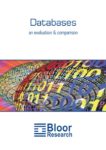Databases
Date:
By: Philip Howard
Classification: Research Report
This report represents a new way of considering the leading database vendors. Instead of considering them simply feature by feature, this report focuses on the different types of applications that you might want to develop. Thus each product is considered in terms of its suitability, not only for conventional applications of various types, but also for supporting web-based applications, implementation on embedded devices and for use as an underpinning to web services, amongst others. We will also consider whether the database can form a more proactive component of the application infrastructure, rather than merely acting as a store for data.
Traditionally, database reports have tended to be technically oriented, focusing on particular features and whether they are or are not supported. This was because the presence or absence of such features was a good indication of whether a particular database product would perform well, for example, under particular conditions. However, today many of these features can be taken as read. The debate over row-level locking, for instance, is dead. While some features remain relevant today (for example, in supporting 24×7 availability or in providing high levels of scalability) and will still be discussed in this report, the emphasis will be on the applications that you might want to build and the suitability of particular products for that purpose.
While the report will only include detailed product reviews of the Oracle 9i, Microsoft SQL Server and IBM’s DB2 products, the report will also consider other database products and designs both in general terms and in their suitability for particular application environments. This will include a consideration of open source databases such as MySQL and Postgres, new database architectures as represented by Lazy Software’s Sentences, as well as more traditional offerings from a variety of vendors.
The Oracle, Microsoft, and IBM database products will be scored and compared according to a benchmark that we will define for the purposes of this report. Additional products may be scored against this benchmark and published separately, at the vendor’s request.

